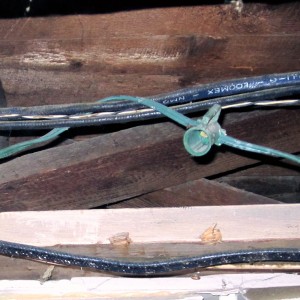With an older home typically comes old knob and tube wiring and the necessity of replacing it to make sure that it is safe and up to current building codes. As we peeled back the layers in the basement we uncovered some astounding electrical woes. This post covers our work to date on how we plan on rewiring an old house in phases.
The entire house was running on only a handful of breakers, because of that and the age of the house we were expecting to find some knob and tube and overloaded, hidden junction boxes. However, we were still surprised at some of the issues we encountered. These included:
- Knob and tube wiring.
- Rats nest of wires inside junction boxes.
- Cut wires that were not properly tied off.
- Almost the entire first floor on one breaker.
- No ground fault circuit interrupter (GFCI).
- Plugs falling out of the receptacles.
- A Christmas light strand used as a connecting wire!
Check out all the pictures at the end of the post for some evidence of the disasters we found.
Since this was not going to be a straight forward electrical job we decided to reach out to a licensed electrician to complete the work. We looked for electricians on HomeStars but ended up going with a licensed electrician who was highly recommended by a family friend. He has lived up to his high recommendation. If you are looking for an electrician in the Toronto area we would be glad to refer you.
The first thing we did was remove old plugs and lights in the basement and had our electrician safely remove/replace the knob and tube as well as clean up the overloaded junction boxes. We also added some new extra lights in the basement to make it easier to work. Our electrician helped us plan out how we are going to tackle rewiring an old house and we are approaching the work room by room starting with the main floor:
Living room:
- Rewired existing outlets (2).
- Added a new outlet.
- Moved to its own circuit.
Dining room:
- Rewired existing outlet.
- Added a new outlet.
- Moved to its own circuit.
Kitchen
- Dedicated line for the fridge.
- Dedicated line for the dishwasher.
- Dedicated 240 volt plug in case we ever want to use an electric stove.
- Dedicated line for the gas range.
- Upgrading the only existing counter plug to GFCI.
- Three new GFCI plugs added to the counter tops.
Exterior
- Adding a light to the front of the house.
Once we have the list above complete we will get a permit and have the work inspected by the city. This is still a work in progress and we are continuing to work on this almost every week with the aim to be complete by the spring.
There is still a lot of electrical work to be done after the main floor phase. The next stage will be to tackle the upstairs, running new wires up to the second floor to update the outlets, safely replace any knob and tube we are likely to find, properly rewire the light fixtures and add additional outlets.
The slow approach to updating the electrical requires patience, and sometimes we are tempted to rip open all the walls and just get it all done at once but we are being practical as to what we can afford to do and even though it is slow we are gaining peace of mind knowing that the electrical work is progressing to make our house safer.













Comments